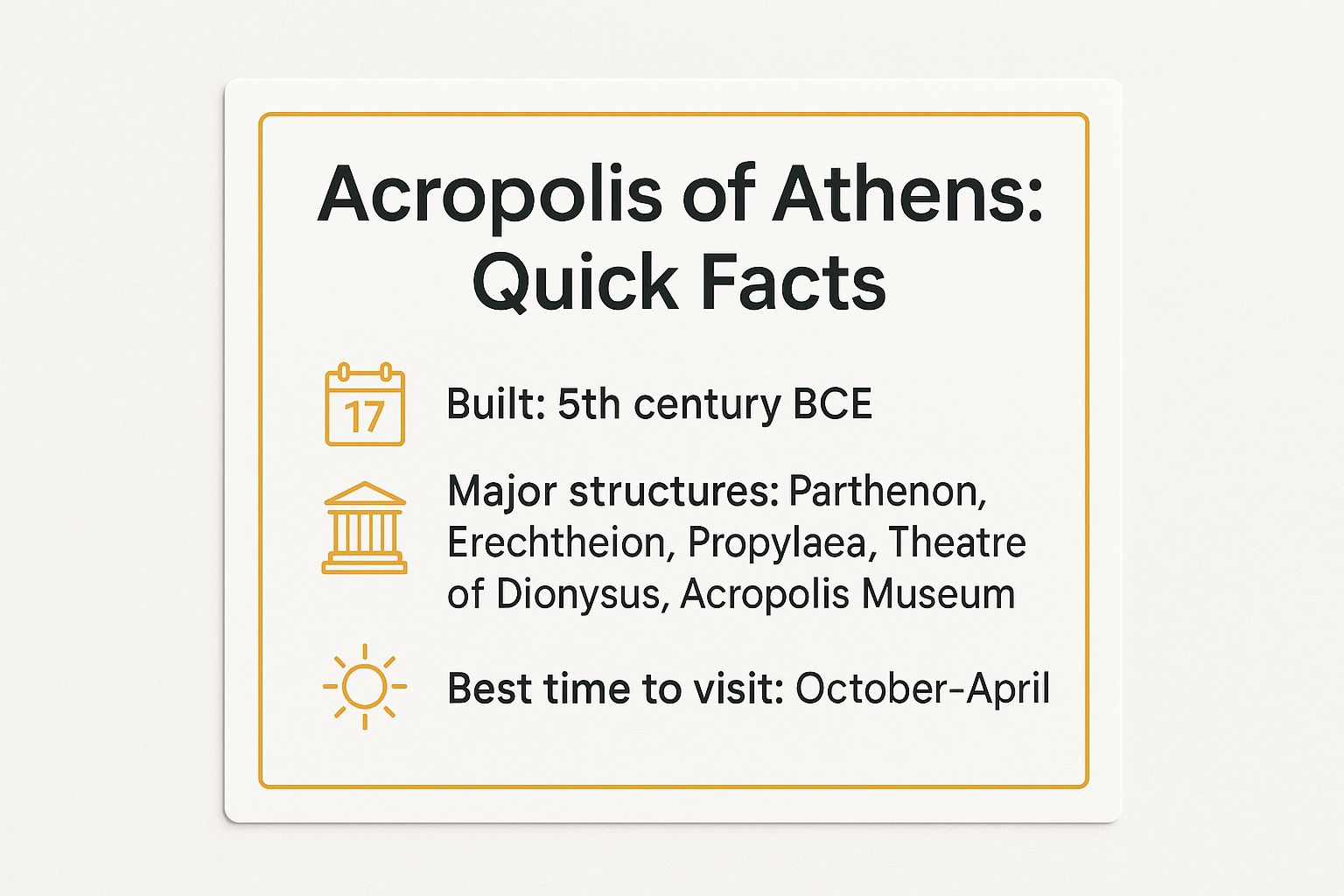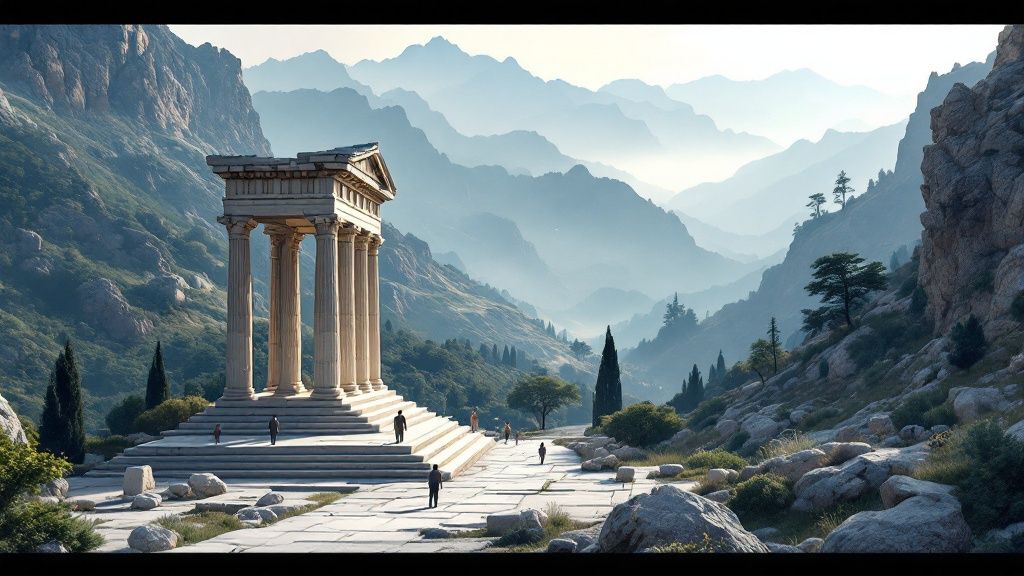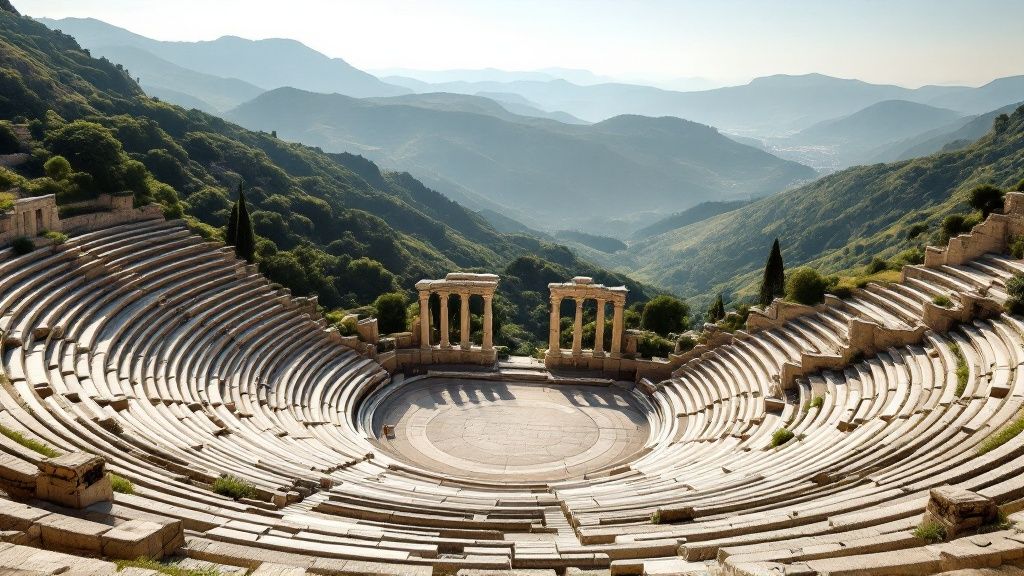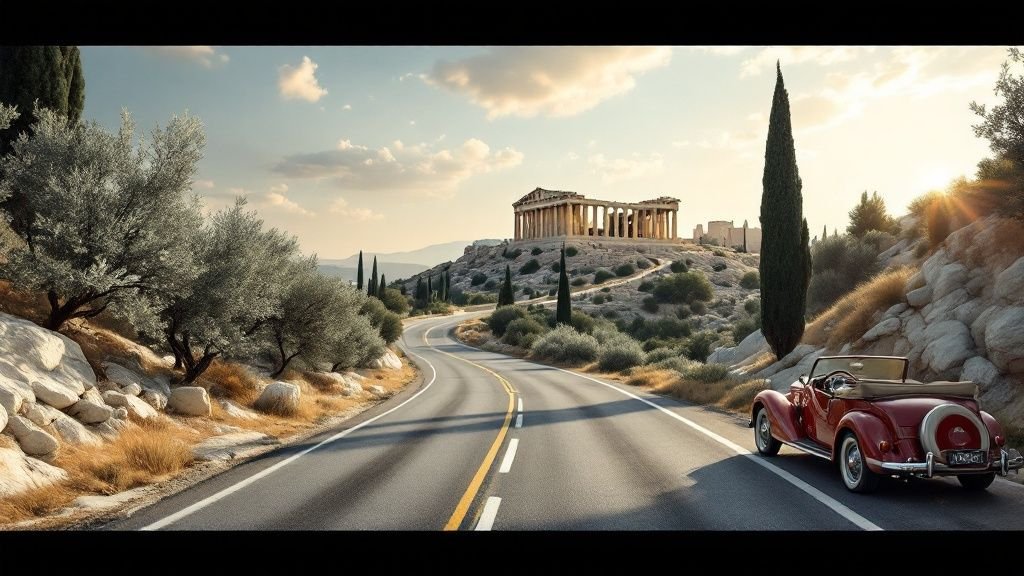Greece is a land where myths are etched into mountains and history whispers from every sun-bleached stone. While the vibrant islands are legendary, the true heart of this ancient nation lies within its monumental ruins. This guide is your key to unlocking the stories behind the 10 most essential ancient ruins in Greece, moving beyond standard facts to offer practical, actionable insights for the independent traveller.
We have curated a list that covers everything from the iconic Acropolis to the mystical monasteries of Meteora. For each site, you will find not just historical context, but also specific tips on navigating the grounds, avoiding crowds, and discovering lesser-known details that bring the past to life.
This article is designed to be a practical roadmap. We will provide detailed self-drive itineraries that connect these timeless wonders, allowing you to craft a personalised journey through the cradle of Western civilisation. Whether you're a history enthusiast planning a solo adventure or a family seeking a flexible cultural exploration, this guide will help you experience Greece's archaeological treasures at your own pace. Prepare to walk in the footsteps of gods, heroes, and philosophers on an unforgettable road trip.
1. Acropolis of Athens
Towering over the modern capital, the Acropolis of Athens is an enduring symbol of Western civilisation and arguably the most significant of all ancient ruins in Greece. This ancient citadel, perched on a rocky outcrop, was primarily constructed during the 5th century BCE under the visionary Athenian statesman, Pericles. It represents the zenith of Classical Greek artistic and architectural achievement, a testament to the birth of democracy and philosophy.
The complex is home to several masterpieces, most notably the Parthenon, a former temple dedicated to the goddess Athena. Its design, overseen by the architects Ictinus and Callicrates and the sculptor Phidias, showcases unparalleled precision and aesthetic harmony. Other key structures include the Erechtheion, with its famous Porch of the Caryatids, and the monumental gateway, the Propylaea.
Practical Tips for Your Visit
To make the most of your exploration, strategic planning is essential. The smooth, ancient marble can be slippery, so comfortable, non-slip footwear is a must.
- Best Time to Visit: Arrive right at the 8 AM opening or late in the afternoon to avoid the intense midday heat and the largest tour groups.
- Ticketing: Purchase the combined ticket online in advance. It grants access to the Acropolis and six other major archaeological sites in Athens, saving both time and money.
- What to Bring: The site has very little shade. A hat, high-SPF sunscreen, and plenty of water are non-negotiable, especially in summer.
- Time Allotment: Dedicate at least 3-4 hours to fully appreciate the site and the magnificent Acropolis Museum located at its base.
The infographic below offers a quick summary of essential facts for planning your trip.

As the summary highlights, visiting during the off-peak season from October to April provides a more comfortable and less crowded experience, allowing for deeper engagement with these monumental structures.
2. Delphi
Clinging to the slopes of Mount Parnassus, the Panhellenic sanctuary of Delphi was considered the centre of the world by ancient Greeks. This breathtaking site was home to the most famous oracle in antiquity, where the Pythia, a high priestess of Apollo, delivered cryptic prophecies that guided kings, generals, and common folk alike for centuries. Its influence was so profound that no major decision was made without consulting the Oracle of Delphi first.

The sprawling complex features the remains of the Temple of Apollo, where the oracle resided, an impressively preserved ancient theatre, and a stadium perched at the highest point. As you walk the Sacred Way, you'll pass the treasuries of various city-states, such as the reconstructed Treasury of the Athenians, showcasing the wealth and devotion poured into this sacred place, making it one of the most spiritually significant ancient ruins in Greece.
Practical Tips for Your Visit
To fully absorb the mystical atmosphere of Delphi, a well-planned visit is crucial. The site is spread across a steep mountainside, so thoughtful preparation will enhance your experience.
- Best Time to Visit: Aim for an early morning arrival to explore the outdoor site before the afternoon sun becomes too strong. The mountain location often means cooler, clearer mornings.
- Ticketing: Purchase a combined ticket that includes both the archaeological site and the adjacent Delphi Archaeological Museum. It’s best to visit the museum first to contextualise the ruins and see incredible finds like the Charioteer of Delphi.
- What to Bring: The mountain weather can be unpredictable. Wear sturdy walking shoes for the steep paths and bring layers of clothing, including a waterproof jacket, even on a sunny day.
- Time Allotment: Plan for a full day. Dedicate at least 3-4 hours to the archaeological site and another 2 hours for the museum. Consider staying overnight in the nearby modern town of Delphi to avoid a rushed day trip from Athens.
3. Olympia
Nestled in the lush valley of the Alpheios river in the western Peloponnese, Ancient Olympia is renowned worldwide as the birthplace of the Olympic Games. This sacred sanctuary, first established in 776 BCE, was dedicated to Zeus and served as the celebrated venue for the games for almost 12 centuries. It was a place of immense religious and athletic importance, attracting people from all corners of the ancient Greek world.
The sprawling archaeological site contains a treasure trove of ruins that speak to its former grandeur. Key structures include the remains of the magnificent Temple of Zeus, which once housed Phidias's colossal gold and ivory statue, one of the Seven Wonders of the Ancient World. Visitors can also explore the Palaestra where athletes trained, the workshop of Phidias, and the original Olympic stadium, where you can still see the starting line etched in stone. Its unique place in history makes it a vital stop among the ancient ruins in Greece.
Practical Tips for Your Visit
To fully appreciate the scale and history of Olympia, a little planning goes a long way. The site is extensive, so prepare for a significant amount of walking.
- Best Time to Visit: Aim for the spring (April-May) or autumn (September-October) for pleasant weather. During summer, visit early in the morning or late afternoon to avoid the peak heat.
- Site Strategy: Visit the excellent Archaeological Museum of Olympia first. Seeing the original sculptures and artefacts provides crucial context that brings the ruins to life.
- What to Bring: Sun protection is essential. Wear a wide-brimmed hat, apply high-SPF sunscreen, and carry at least one large bottle of water per person as shade is limited.
- Time Allotment: Dedicate a minimum of 4-5 hours to explore both the archaeological site and the museum without rushing. If you're planning a multi-day trip, you can learn more about an itinerary featuring Olympia on btours.com.
4. Epidaurus
Nestled in the tranquil landscape of the Peloponnese, the Sanctuary of Asklepios at Epidaurus was the most celebrated healing centre of the ancient world. Dedicated to the god of medicine, this expansive site was a spiritual and therapeutic destination where people sought cures for their ailments through a blend of religious rituals, medicinal practices, and immersive cultural experiences. Today, it stands as one of the most complete ancient ruins in Greece.

While the complex includes the remains of temples and patient dormitories, its crowning glory is the magnificent Theatre of Epidaurus. Designed by Polykleitos the Younger in the 4th century BCE, the theatre is famed for its flawless acoustics, allowing a whisper or a coin drop on stage to be heard perfectly from the highest seats. This architectural marvel was integral to the healing process, as it was believed dramatic performances could harmonise the mind and body.
Practical Tips for Your Visit
To truly appreciate the unique atmosphere of Epidaurus, a little planning goes a long way. Beyond marvelling at the main theatre, take time to explore the broader sanctuary and its serene surroundings.
- Test the Acoustics: Don't just take our word for it. Head to the centre of the stage and whisper or drop a coin; it's a magical experience to have someone confirm they heard it from the top row.
- Best Time to Visit: Arrive early in the morning to test the acoustics before large crowds arrive. The shoulder seasons (April-May, September-October) offer a more peaceful visit.
- What to Bring: The site is quite exposed. Bring a hat, sun cream, and water. Comfortable shoes are essential for climbing the theatre's stone steps and exploring the wider ruins.
- Time Allotment: Allow at least 2-3 hours to see the theatre, the museum, and the ruins of the sanctuary, including the Tholos and the Abaton where patients would sleep.
5. Mycenae
Stepping into the Bronze Age, Mycenae was a formidable centre of Greek civilisation from 1600 to 1100 BCE, immortalised in Homer's epics as the legendary kingdom of King Agamemnon. This ancient citadel, set upon a low hill, commands the plains of Argolis. It represents the pinnacle of the Mycenaean civilisation, the first advanced, palace-centred society on mainland Greece, predating the classical era by centuries.
The site is famed for its monumental Lion Gate, the main entrance to the citadel, and its massive "Cyclopean walls," so named because later Greeks believed only mythical giants could have built them. Excavations led by Heinrich Schliemann in the 19th century unearthed royal shaft graves filled with gold treasures, revealing the immense wealth and power of its rulers. The nearby beehive-shaped Treasury of Atreus is a magnificent example of Mycenaean funerary architecture.
Practical Tips for Your Visit
To fully grasp the scale and historical weight of Mycenae, a little preparation goes a long way. The terrain is uneven and rocky, so appropriate footwear is crucial for a comfortable exploration of these impressive ancient ruins in Greece.
- Best Time to Visit: An early morning visit is ideal for avoiding the harshest sun and capturing the best photographs in the soft light.
- Don't Miss: The Treasury of Atreus (also called the Tomb of Agamemnon) is located about 500 metres from the main citadel. Ensure you walk down to see this astounding tholos tomb.
- What to Wear: Sturdy, closed-toe walking shoes are essential for navigating the rough ancient stones and steep pathways safely.
- Enrich Your Visit: Reading a summary of Homer's Iliad or the story of Agamemnon before you arrive will provide powerful context and bring the silent stones to life.
- Time Allotment: Allow a minimum of 2-3 hours to thoroughly explore the main citadel, the on-site museum, and the nearby tombs without rushing.
6. Meteora Monasteries
Suspended between earth and sky, Meteora presents one of the most visually stunning and spiritually profound landscapes in Greece. While the monasteries themselves are medieval Byzantine masterpieces, the site's history is rooted in antiquity, with hermitages existing in the caves of these colossal rock pillars for centuries prior. The complex of six active Orthodox Christian monasteries, perched atop these natural sandstone towers, creates an otherworldly spectacle.
Founded in the 14th century by figures like Saint Athanasius, this monastic community sought spiritual isolation and protection, finding it in this unique geological setting. The name Meteora itself means "suspended in the air," perfectly capturing the awe-inspiring engineering and faith required to construct these sacred havens. It remains a vital centre of Orthodox monasticism and a testament to centuries of devotion, earning its place on any list of significant historical sites in Greece.
Practical Tips for Your Visit
Respectful and careful planning will greatly enhance your visit to this sacred and physically demanding location. Modesty in dress is mandatory for entering the monasteries, requiring covered shoulders and long trousers or skirts.
- Best Monasteries to Visit: Prioritise the Great Meteoron for its size and historical importance, and Varlaam for its impressive frescoes and architecture.
- Scheduling: Each monastery operates on a different schedule and has at least one closing day per week. Check the timetables online before you go.
- What to Bring: Wear sturdy, comfortable walking shoes for the many stairs. Bring layers, as the weather can change quickly at altitude, and water is essential.
- Time Allotment: Plan to stay overnight in the nearby towns of Kalambaka or Kastraki. This allows you to experience the magical sunrise and sunset views and explore the area over two days without rushing.
For those planning a self-drive adventure through this region, combining Meteora with other natural wonders is an excellent option. A multi-day itinerary can provide a deeper appreciation of the area's rich history and landscapes. Learn more about a hiking and driving tour of Meteora on btours.com.
7. Delos
Just a short ferry ride from Mykonos lies the sacred island of Delos, one of the most significant archaeological sites in the entire Mediterranean. According to Greek mythology, this tiny, arid island was the birthplace of the twin gods Apollo and Artemis, making it a major religious centre for centuries. Its importance grew as it became the treasury and nominal headquarters of the Delian League, an alliance led by Athens, cementing its status as a pivotal commercial and spiritual hub in the ancient world.
Today, the entire island is an open-air museum, a UNESCO World Heritage site showcasing extensive ruins from the Archaic, Classical, and Hellenistic periods. Visitors can wander through the remains of grand temples, a theatre, and luxurious mosaic-floored houses. Key highlights include the iconic Terrace of the Lions, a row of marble guardians protecting the Sacred Lake, and the remarkably preserved mosaics in the House of Dionysus. Exploring these ancient ruins in Greece offers a unique glimpse into the daily life and religious fervour of a bygone era.
Practical Tips for Your Visit
A day trip to Delos requires some forethought, as the island is uninhabited and has minimal facilities. Proper preparation ensures you can fully immerse yourself in its rich history.
- Best Time to Visit: Take the first boat from Mykonos in the morning. This gives you maximum time to explore before the afternoon heat and crowds arrive.
- Ticketing: Purchase your return ferry ticket in advance, especially during peak season. The archaeological site entrance fee is paid separately upon arrival on Delos.
- What to Bring: There are no shops on the island. Sun protection is critical, so bring a wide-brimmed hat, high-SPF sunscreen, and sunglasses. Pack plenty of water and some snacks.
- Time Allotment: Plan for at least 4-5 hours to cover the main areas without rushing. Comfortable, sturdy walking shoes are essential for navigating the uneven ancient paths.
8. Palace of Knossos (Crete)
Stepping into the Palace of Knossos is like entering a different world, one that predates Classical Greece by over a millennium. Located just south of Heraklion on the island of Crete, this was the ceremonial and political centre of the Minoan civilisation, Europe's first advanced civilisation. The labyrinthine complex, famously associated with the legend of King Minos and the Minotaur, reveals a society of remarkable sophistication, with multi-storey buildings, intricate frescoes, and advanced drainage systems.
Excavated and controversially reconstructed by archaeologist Sir Arthur Evans in the early 20th century, the site offers a unique, albeit debated, glimpse into Bronze Age life. Key areas to explore include the Throne Room, believed to be the oldest in Europe, the vibrant Grand Staircase, and the Queen's Megaron with its iconic dolphin fresco. The palace's complex layout and rich mythology make it one of the most compelling ancient ruins in Greece.
Practical Tips for Your Visit
To navigate this vast and complex site effectively, a little preparation goes a long way. The sheer scale and historical depth can be overwhelming without a plan.
- Best Time to Visit: Arrive at the 8 AM opening to explore the central court and key rooms before the large tour buses arrive from the coast.
- Context is Key: Familiarise yourself with Minoan history beforehand. It is a distinct culture from mainland Greece, and understanding this will greatly enhance your appreciation.
- Ticketing: Book a combined ticket that includes entry to the Heraklion Archaeological Museum. This is essential, as the museum houses the original frescoes and artefacts removed from the site for preservation.
- Time Allotment: Plan for at least 3-4 hours to explore the palace grounds thoroughly. Consider hiring a licensed guide or using an audio guide to make sense of the intricate layout.
9. Ancient Corinth
Strategically positioned on the narrow isthmus connecting the Peloponnese to mainland Greece, Ancient Corinth was a formidable commercial and maritime powerhouse. This vital location allowed it to control trade routes, making it one of the largest and most important city-states of the ancient world. Famous in antiquity for its wealth and luxury, the site today reveals layers of Greek, Roman, and Byzantine history.
The archaeological site showcases the extensive Roman city built upon its Greek predecessor, with highlights including the vast forum, the Peirene Fountain, and the monumental Temple of Apollo. This 6th-century BCE Doric temple is one of the oldest in Greece and its monolithic columns stand as a stark, powerful landmark against the landscape. The city's importance was later cemented when St. Paul the Apostle lived and preached here, making it a key centre for early Christianity.
Practical Tips for Your Visit
To truly grasp Corinth's significance, a visit should encompass both the lower city and its imposing acropolis. Good walking shoes are essential for exploring the sprawling site and the steep fortress.
- Best Time to Visit: Visit the lower city in the morning before tackling the climb to Acrocorinth in the cooler late afternoon.
- Ticketing: A single ticket covers the archaeological site and the on-site museum. It’s best to visit the museum first to contextualise the ruins you are about to see.
- What to Bring: The climb to Acrocorinth is exposed. Ensure you have ample water, sun cream, and a hat. The panoramic views from the top are worth the effort.
- Time Allotment: Plan for a full day to properly explore both Ancient Corinth and the medieval fortress of Acrocorinth, which offers its own extensive ruins.
10. Vergina (Aigai)
Hidden in the foothills of northern Greece, Vergina is the modern name for Aigai, the first capital of the ancient kingdom of Macedon. This UNESCO World Heritage site is most famous for its extraordinary royal tombs, which were discovered intact in 1977 by archaeologist Manolis Andronikos. It is one of the most profound ancient ruins in Greece, offering a direct glimpse into the opulent world of Macedonian royalty just before its rise to global dominance.
The site’s centrepiece is the burial tumulus containing several tombs, most notably that of Philip II, father of Alexander the Great. Visitors descend into a subterranean museum built around the tombs, preserving them at a constant temperature. Inside, you can view the tomb façades and a breathtaking collection of grave goods, including intricate golden wreaths, armour, and the famous golden larnax that held Philip II's remains.
Practical Tips for Your Visit
To fully appreciate the historical weight of Vergina, a little preparation goes a long way. The main museum is underground and can be cool, even on a hot day.
- Best Time to Visit: The site is less crowded on weekday mornings. Visiting during the shoulder seasons (spring and autumn) offers pleasant weather for exploring the wider palace ruins.
- Ticketing: Purchase tickets on-site. Consider hiring a licensed guide to truly understand the complex history and the significance of the artefacts you are viewing.
- What to Bring: Wear comfortable shoes for walking between the tomb museum and the separate ruins of the palace and theatre. Note that photography is strictly forbidden inside the tomb museum.
- Time Allotment: Plan for at least 3-4 hours to properly experience the tomb museum, the newer Polycentric Museum, and the palace ruins on the hill above.
Vergina is a cornerstone of any northern Greece itinerary, often combined with a visit to nearby Pella, Alexander the Great's birthplace. For those looking to explore the region in depth, you can learn more about a tour of Northern Greece's treasures that organises these key historical stops.
Key Features Comparison of 10 Ancient Greek Ruins
| Site | Implementation Complexity | Resource Requirements | Expected Outcomes | Ideal Use Cases | Key Advantages |
|---|---|---|---|---|---|
| Acropolis of Athens | Moderate (steep climb, ongoing restorations) | Accessible urban location, tickets, guide | Iconic classical architecture, democratic symbolism | Educational, historical tourism | Well-preserved UNESCO site, comprehensive museum |
| Delphi | Moderate to High (mountain terrain, full-day visit) | Travel from Athens, walking/climbing stamina | Insight into ancient religion and oracles | Mythology enthusiasts, scenic trekking | Dramatic setting, well-preserved monuments |
| Olympia | Moderate (remote location, some ruins fragmentary) | Longer travel, museum visit recommended | Understanding of Olympic origins, religious site | Sports history fans, quiet exploration | Authentic Olympic stadium, peaceful environment |
| Epidaurus | Low to Moderate (mainly theater, smaller site) | Car or tour necessary, half-day visit | Experience of ancient medical sanctuary and theater | Theater lovers, cultural tourism | Best-preserved theater, exceptional acoustics |
| Mycenae | Moderate (steep climbs, imaginative visualization) | Travel to site, sturdy footwear | Bronze Age civilization insights, Homeric connections | Archaeology and mythology enthusiasts | Cyclopean walls, legendary royal tombs |
| Meteora Monasteries | Moderate to High (hiking, dress codes) | Hiking ability, respect for spiritual rules | Unique religious heritage and dramatic scenery | Religious tourism, nature and photography lovers | Spectacular rock formations, active monastic life |
| Delos | Moderate (boat access, no amenities) | Boat trip, bring supplies | Archaeological island exploration, religious history | Archaeology buffs, mythology interest | Uninhabited, well-preserved ruins, island setting |
| Palace of Knossos | Moderate (combination of original and reconstructed elements) | Travel to Crete, museum visit | Insight into Europe's first civilization | Minoan civilization enthusiasts | Advanced Bronze Age architecture, vivid frescoes |
| Ancient Corinth | Low to Moderate (mixed Greek-Roman ruins) | Accessible by car, museum visit | Mixed historical layers, biblical connections | Historical and biblical tourism | Fortress views, Greek and Roman heritage |
| Vergina (Aigai) | Moderate (remote northern location) | Guided tours recommended, museum access | Royal Macedonian tombs, archaeological significance | Ancient Macedonian history enthusiasts | Well-preserved tombs, unique underground museum |
Your Hellenic Adventure Awaits
The journey through Greece’s most profound archaeological treasures reveals a narrative woven from myth, might, and monumental achievement. From the sun-bleached marble of the Acropolis, where democracy first found its voice, to the mystical slopes of Delphi, where futures were foretold, each site offers a distinct chapter in the epic story of Western civilisation. We have travelled from the thunderous applause once heard in the theatre of Epidaurus to the solemn royal tombs of Vergina, and from the Minoan labyrinth of Knossos to the sacred island of Delos. These are not merely collections of stones; they are the very foundations of our modern world’s art, philosophy, politics, and sport.
Exploring the diverse landscape of ancient ruins in Greece is an unparalleled experience, one that shifts from awe-inspiring to deeply personal. The true magic unfolds when you realise the human scale of these places. Standing in the starting blocks at Olympia or gazing across the Argive Plain from the citadel of Mycenae connects you directly to the individuals who lived, worshipped, and competed here millennia ago. A self-drive tour transforms this historical pilgrimage into a personal adventure, granting you the freedom to create your own narrative among these legendary settings.
Weaving Your Own Mythical Itinerary
The key takeaway is that these sites are not isolated wonders but interconnected points on a historical map. A self-drive journey allows you to trace these connections at your own pace. Imagine starting in Athens, absorbing the classical grandeur, before driving towards the Peloponnese to uncover the Bronze Age mysteries of Mycenae and the athletic heritage of Olympia. This approach offers practical benefits:
- Flexibility: Linger longer at a site that captivates you or take a spontaneous detour to a coastal village for lunch.
- Authenticity: Discover the landscapes that inspired the ancients, driving through olive groves and mountain passes that have remained unchanged for centuries.
- Personalisation: Combine major archaeological sites with lesser-known gems, crafting a route that perfectly aligns with your interests, whether they lean towards military history, spiritual quests, or theatrical arts.
Before you finalise your plans and book your flights, ensure your travel documentation is in order. For many non-EU visitors, understanding the Schengen Visa requirements is a crucial first step, ensuring a smooth and hassle-free entry into Greece. Preparing this in advance allows you to focus entirely on the incredible journey ahead. Ultimately, a trip to explore the ancient ruins in Greece is more than a holiday; it's an active dialogue with the past, an opportunity to walk in the footsteps of legends and build a timeless story of your own.
Ready to turn this historical roadmap into your reality? Let BTOURS craft your bespoke self-drive itinerary through Greece, combining iconic ruins with authentic local experiences. Visit BTOURS to start planning your personalised journey through the heart of the ancient world.



